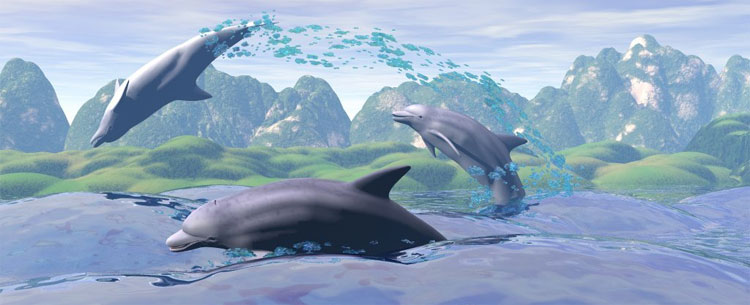   |
| Along
the Mid-Atlantic coast of the
United States, there are different
sub-populations, or stocks
of bottlenose dolphins. The
bottlenose dolphin, Tursiops
truncatus, has both resident
and migratory stocks. The focus
of this study is the northern
migratory population. This
group of animals moves north
and south along the coast in
response to seasonal changes.
The need for study arises from
this mobile nature. Determination
of the environmental cues that
may be used to predict the
presence or absence of these
animals will aid in efforts
to avoid disturbance to this
protected species. This stock
was also greatly affected during
the 1987-1988 epizootic event
that killed an estimated 50%
of the migratory stock. This
disease event was likely worsened
by exposure to environmental
toxins. The main areas of the
field work, the lower James
and Elizabeth Rivers of Virginia,
are of interest due to their
high toxin loads and frequent
usage by bottlenose dolphins.
The Elizabeth River is largely
developed along its length.
It also has a very high level
of traffic: commercial, military
and recreational. Since this species represents the highest level on its food chain, our hypothesis is that the movement north represents can be correlated with the movements of their prey species. These prey species are known to be themselves migratory with temperature. As a surrogate for the in situ detection of the prey species, we feel that sea surface temperature (SST) and chlorophyll-a levels can be used. Both of these factors can be sensed remotely, removing the need for local observations. Sea surface temperature can serve to represent the movement of the prey species, and chlorophyll-a levels can be used to show the primary productivity, and thus the total food energy available in the ecosystem. The presence and absence data on these animals is then to be compared with the remotely sensed SST and chlorophyll-a data. These data were derived from a number of sources. MODIS-Aqua and AVHRR data was obtained from Goddard Space Flight Centers Ocean Color web archive. Additional AVHRR data was obtained from the Jet Propulsion Laboratory’s PO.DAAC Ocean ESIP Tool (POET) website. Field observations were based on archives from the Christopher Newport University Dolphin Project, and from the Ocean Biogeographic Information System (OBIS) archive of Duke University. The results of the correlations show that the critical temperature in determining the presence or absence of bottlenose dolphins is between 16° and 18° C. While there were two sightings below this temperature, there were 694 above. A t-test show that there was a significant (p=0.003) difference between the mean temperatures of sighting and non-sighting efforts. When compared to the numbers of animals sighted at the different temperatures, again the 16° and 18° critical temperatures showed up. There were only 2 animals sighted below 16°, while there were 5400 sighted above. An ANOVA analysis showed a significant (p<0.01) difference between the two temperature ranges when it came to group size. A t-test for the mean group size showed no significant difference in the sizes of groups between 18° and 28°. While there was some variation in the chlorophyll levels (measured in mg/m3), a t-test showed no significant (p>0.1) difference between the means of sighting and non-sighting levels. In comparing chlorophyll-a levels with group size, there was a significant (p<0.001) difference, but this was likely due to the fact that coastal waters never drop below moderate chlorophyll-a levels. Based on these findings, it becomes clear that in determining the migratory movements of bottlenose dolphins sea surface temperature is the preferred environmental variable. |
 |
"Every
time we open our mouths,
men look into our minds." - unknown |